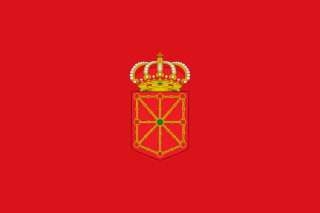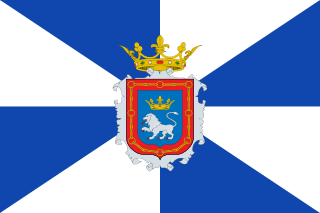Related Research Articles

Navarre, officially the Chartered Community of Navarre, is a landlocked foral autonomous community and province in northern Spain, bordering the Basque Autonomous Community, La Rioja, and Aragon in Spain and Nouvelle-Aquitaine in France. The capital city is Pamplona. The present-day province makes up the majority of the territory of the medieval Kingdom of Navarre, a long-standing Pyrenean kingdom that occupied lands on both sides of the western Pyrenees, with its northernmost part, Lower Navarre, located in the southwest corner of France.

Moriscos were former Muslims and their descendants whom the Catholic Church and Habsburg Spain commanded to forcibly convert to Christianity or face compulsory exile after Spain outlawed Islam. Spain had a sizeable Muslim population, the mudéjars, in the early 16th century.

Tudela is a municipality in Spain, the second largest city of the autonomous community of Navarre and twice a former Latin bishopric. Its population is around 35,000. The city is sited in the Ebro valley. Fast trains running on two-track electrified railways serve the city and two freeways join close to it. Tudela is the capital of the agricultural region of Ribera Navarra, and also the seat of the courts of its judicial district.

The Kingdom of Navarre, originally the Kingdom of Pamplona, was a Basque kingdom that occupied lands on both sides of the western Pyrenees, with its northernmost areas originally reaching the Atlantic Ocean, between present-day Spain and France.

The Alhambra Decree was an edict issued on 31 March 1492, by the joint Catholic Monarchs of Spain ordering the expulsion of practising Jews from the Crowns of Castile and Aragon and its territories and possessions by 31 July of that year. The primary purpose was to eliminate the influence of practising Jews on Spain's large formerly-Jewish converso New Christian population, to ensure the latter and their descendants did not revert to Judaism. Over half of Spain's Jews had converted as a result of the religious persecution and pogroms which occurred in 1391. Due to continuing attacks, around 50,000 more had converted by 1415. A further number of those remaining chose to convert to avoid expulsion. As a result of the Alhambra decree and persecution in the years leading up to the expulsion of Spain's estimated 300,000 Jewish origin population, a total of over 200,000 had converted to Catholicism to remain in Spain, and between 40,000 and 100,000 remained Jewish and suffered expulsion. An unknown number of the expelled eventually succumbed to the pressures of life in exile away from formerly-Jewish relatives and networks back in Spain, and so converted to Catholicism to be allowed to return in the years following expulsion.:17

Philip III, called the Noble or the Wise, was King of Navarre from 1328 until his death. He was born a minor member of the French royal family but gained prominence when the Capetian main line went extinct, as he and his wife and cousin, Joan II of Navarre, acquired the Iberian kingdom and a number of French fiefs.

Lucena is a municipality of Spain belonging to the province of Córdoba, in the autonomous community of Andalusia.

Lope de Barrientos (1382–1469), sometimes called Obispo Barrientos, was a powerful clergyman and statesman of the Crown of Castile during the 15th century, although his prominence and the influence he wielded during his lifetime is not a subject of common study in Spanish history.

Ferdinand II was King of Aragon from 1479 until his death in 1516. As the husband and co-ruler of Queen Isabella I of Castile, he was also King of Castile from 1475 to 1504. He reigned jointly with Isabella over a dynastically unified Spain; together they are known as the Catholic Monarchs. Ferdinand is considered the de facto first king of Spain, and was described as such during his reign, even though, legally, Castile and Aragon remained two separate kingdoms until they were formally united by the Nueva Planta decrees issued between 1707 and 1716.

The Spanish conquest of the Iberian part of Navarre was initiated by Ferdinand II of Aragon and completed by his grandson and successor Charles V in a series of military campaigns lasting from 1512 to 1524. Ferdinand was both the king of Aragon and regent of Castile in 1512. When Pope Julius II declared a Holy League against France in late 1511, Navarre attempted to remain neutral. Ferdinand used this as an excuse to attack Navarre, conquering it while its potential protector, France, was beset by England, Venice, and Ferdinand's own Italian armies.
Antonio Carrillo de Peralta y de Velasco, II Marquis of Falces, deceased in 1545, Marcilla, Navarra, Spain, was the son of Navarrese Conetable of the kingdom of Navarre Alonso Carrillo - Acuña y de Peralta, 1st Marquis of Falces, 2nd Count Consort of Santisteban de Lerín, Sieur Consort of Peralta, Falces, Carcer, and other Navarrese places, deceased and buried at Marcilla, Navarre, in 1534.

Navarro-Aragonese was a Romance language once spoken in a large part of the Ebro River basin, south of the middle Pyrenees; the dialects of the modern Aragonese language, spoken in a small portion of that territory, can be seen as its last remaining forms. The areas where Navarro-Aragonese was spoken might have included most of Aragon, southern Navarre, and La Rioja. It was also spoken across several towns of central Navarre in a multilingual environment with Occitan, where Basque was the native language.

Fortún Garcés Cajal was a Navarro-Aragonese nobleman and statesman, perhaps "the greatest noble of Alfonso the Battler's reign". He was very wealthy in both land and money, and could raise two to three hundred knights for his retinue, funded both out of his treasury and enfeoffed on his lands.

Escors or de Cors, is a family name of French origin probably from the region of Aquitaine or Gascony that moved to Navarre "Escors" is related to other Occitan surnames from Aquitaine and present-day Catalonia that derived form "Cors-Cortis". The name "Cors" permanently incorporated the Occitan medieval demonstrative article "Es-" between the 10th and 12th centuries. Many typographic variants can be found in the documents of the Kingdom of Navarre, or in the Gascon Rolls.
Antisemitism in Spain is the expression through words or actions of an ideology of hatred towards Jews on Spanish soil.

Vela Ladrón or Latrónez was a Spanish nobleman who ruled the Basque counties of Álava, Biscay (Vizcaya) and Guipúzcoa. He succeeded his father as count of Álava in 1155 or 1156. He acquired Biscay around 1160 and Guipúzcoa around 1162. He was effectively an independent prince able to divide his allegiance between the kings of Castile and Navarre.

Sancho Sánchez was an important magnate of the Kingdom of Aragon in the late 11th and early 12th centuries, during the reigns of Sancho Ramírez, Peter I and Alfonso I. He was governor of the important Navarrese tenancies of Erro, the castle of San Esteban de Deyo (1084), the capital city of Pamplona (1092), Aibar and Tafalla (1098) and Falces and Leguín (1112). In Aragon proper, he governed the important fortress of El Castellar overlooking Muslim Zaragoza from 1091 and the town of Ejea from 1113. He held the rank of count from 1085, before that he was a lord (senior).
The Expulsion of Jews from Spain was the expulsion of practicing Jews following the Alhambra Decree in 1492, which was enacted to eliminate their influence on Spain's large converso population and to ensure its members did not revert to Judaism. Over half of Spain's Jews had converted to Catholicism as a result of the Massacre of 1391. Due to continuing attacks, around 50,000 more had converted by 1415. Many of those who remained decided to convert to avoid expulsion. As a result of the Alhambra decree and the prior persecution, over 200,000 Jews converted to Catholicism, and between 40,000 and 100,000 were expelled. An unknown number returned to Spain in the following years. The expulsion led to mass migration of Jews from Spain to Italy, Greece, Turkey and the Mediterranean Basin. One result of the migration was new Jewish surnames appearing in Italy and Greece. The surnames Faraggi, Farag and Farachi, for example, originated from the Spanish city of Fraga.

The History of Pamplona as a city goes back to the 1st millennium B.C. when a settlement of Vascones named Iruña existed. However, the traces of human occupation of the area date back 75,000 years. In the Roman era, the Vascones settlement was converted into a Roman city by General Pompey, who began by setting up a military camp there in 74 B.C. which he named Pompelo.
References
- ↑ Domínguez Ortiz, Antonio (1960). "Una provisión de Felipe II en favor de los conversos de Navarra". Miscelánea de Estudios Árabes y Hebraicos. Sección Hebreo. 9. Granada: Editorial Universidad de Granada. doi:10.30827/meahhebreo.v9i0.822.
- ↑ Orta Rubio, Esteban (1998). "Los cristianos nuevos de Navarra. Algunas consideraciones" (PDF). n Mito y Realidad en la Historia de Navarra. Actas del IV Congreso de Historia de Navarra. Pamplona. p. 108.
{{cite book}}: CS1 maint: location missing publisher (link) - ↑ Gampel, Benjamin R. (1986). "The Last Jews on Iberian Soil: Navarrese Jewry, 1479-1498". Proceedings of the American Academy for Jewish Research. 53: 59, 62. doi:10.2307/3622608. JSTOR 3622608.
- ↑ Gampel 1986, p. 65.
- ↑ Gampel 1986, p. 66.
- ↑ Orta Rubio 1998, p. 108.